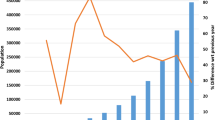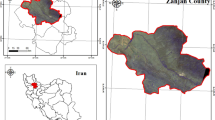Abstract
Understanding and modeling land use and land cover changes are critically important subjects for the purposes of environmental management, planning, and civil engineering. Models are considered as good approaches for having better estimation or understanding of the phenomenon of land use, land cover changes, thoughtful planning, and alteration in better management of cities and villages. Therefore, this study was conducted to analyze and compare the three models of logistic regression, ANNs, and Geo-Mod in predicting the expansion of built-up areas in a 10-year period in Marivan city, Iran. For this purpose, land cover maps at different times were prepared using Landsat data, including the images of the TM sensor of Landsat 5 in 1989, the ETM+ sensor of Landsat 7 in 2000, and the TM sensor of Landsat 5 in 2011. According to the results, during the period from 1989 to 2011, the built-up area of land cover has been multiplied by 2.74 (73.63 ha/year), which is equal to 1296 ha in 2011 compared to 459 ha in 1989. According to the results, logistic regression has been the preferred method in modeling changes to built-up areas among the presented methods. In addition, one of the advantages of logistic regression is to determine the relationship between variables and changes to the built-up areas. Although Geo-Mod yielded poorer results than the other two methods, its advantages of the neighborhood rule and the maximum use of available data should not be disregarded.



Similar content being viewed by others
References
Aldrich, J. H., & Nelson, F. D. (1986). Linear probability, logit and probit models (3rd ed.). Beverly Hills, CA: SAGE Publications.
Avashia, V., Parihar, Sh., & Garg, A. (2020). Evaluation of classification techniques for land use change mapping of India cities. Journal of the Indian Society of Remote Sensing. https://doi.org/10.1007/s12524-020-01122-7.
Bishop, C. M. (1995). Neural networks for pattern recognition. Oxford: Oxford University Press, Inc.
Cabral, P., & Zamyatin, A. (2006). Three land change models for urban dynamics analysis in Sintra-Cascais area. In 1st EARSeL workshop of the SIG urban remote sensing Humboldt-Universität zu Berlin, March 2–3, 2006.
Cybenko, G. (1989). Approximation by superposition’s of a sigmoidal function. Mathematics of Control, Signals, and Systems, 2(4), 303–314.
Dushku, A., & Sandra, B. (2003). Spatial modeling of baselines for LULUCF carbon projects: The GEOMOD modeling approach. In International conference on topical forests and climate change: Manila, October 21, 2003.
Easteman, J. R. (2009). IDRISI Taiga guide to GIS and image processing. Worcester: Clark Labs, Clark University.
Giriraj, A., Irfan-Ullah, M., Murthy, M. S. R., & Beierkuhnlein, C. (2008). Modelling spatial and temporal forest cover change patterns (1973–2020): A case study from South Western Ghats (India). Sensors (Basel), 8(10), 6132–6153.
Haykin, S. (1998). Neural networks: A comprehensive foundation (2nd ed.). Upper Saddle River: Prentice Hall PTR.
Kazemi, M., Mahdavi, Y., Nohegar, A., & Rezaie, P. (2011). Estimate land use and land cover change using RS and GIS techniques (Case study: Tangeh-Bostanak watershed, Shiraz). Journal of Applied RS and GIS Techniques in Natural Resource Science, 2(1), 101–111.
Lek, S., Delacoste, M., Baran, P., Dimopoulos, Y., Lauga, J., & Aulanier, S. (1996). Application of neural networks to modelling non-linear relationships in ecology. Ecological Modelling, 90, 39–52.
Lek, S., & Guégan, J. F. (1999). Artificial neural networks as a tool in ecological modelling, an introduction. Ecological Modelling, 120(2–3), 65–73.
Li, X., & Yeh, A. G. (2004). Neural-network-based cellular automata for simulating multiple land use changes using GIS. Geographical Information Science, 16(4), 323–343.
López, E., Gerardo, B., Manuel, M., & Emilio, D. (2001). Predicting land-cover and land-use change in the urban fringe: A case in Morelia city, Mexico. Landscape and Urban Planning, 55(4), 271–285.
Maithani, S., Jain, R. K., & Arora, M. K. (2007). An artificial neural network based approach for modelling urban spatial growth. ITPI Journal, 4(2), 43–51.
Marin, S. L., Nahuelhual, L., Echeverria, C., & Grant, D. E. (2011). Projecting landscape changes in southern Chile: Simulation of human and natural processes driving land transformation. Ecological Modelling, 222(15), 2841–2855.
Mas, J. F., Puig, H., Palacio, J. L., & Sosa-López, A. (2004). Modelling deforestation using GIS and artificial neural networks. Environmental Modelling and Software, 19(5), 461–471.
Nazmfar, H., & Jafarzadeh, J. (2018). Classification of satellite images in assessing urban land use change using scale optimization in object-oriented processes (A case study: Ardabil city, Iran). Journal of the Indian Society of Remote Sensing, 46, 1983–1990. https://doi.org/10.1007/s12524-018-0850-7.
Park, S., Jeon, S., Kim, S., & Choi, C. (2011). Prediction and comparison of urban growth by land suitability index mapping using GIS and RS in South Korea. Landscape and Urban Planning, 99(2), 104–114.
Pijanowski, B. C., Daniel, G. B., Bradley, ASh., & Gaurav, A. M. (2002). Using Neural networks and GIS to forecast land use changes: A land transformation model. Computers, Environment and Urban Systems, 26(6), 553–575.
Pontinus, R. G., & Malanson, J. (2005). Comparison of the structure and accuracy of two land change models. International Journal of Geographical Information Science, 19(2), 243–265.
Pontius, R. G. (2002). Statistical methods to partition effects of quantity and location during comparison of categorical maps at multiple resolutions. Photogrammetric Engineering and Remote Sensing, 68(10), 1041–1049.
Pontius, R. G., Cornell, J. Y., & Hall, C. (2001). Modeling the spatial pattern of land-use change with GEOMOD2: Application and validation in Costa Rica. Agriculture, Ecosystems and Environment, 85(1–3), 191–203.
Pontius, R. G., & Schneider, L. (2001). Land-cover change model validation by a ROC method for the Ipswich watershed, Massachusetts, USA. Agriculture, Ecosystems and Environment, 85(1–3), 239–248.
Qiao, W., Gao, J., Liu, Y., Qin, Y., Lu, Ch., & Ji, Q. (2017). Evaluation of intensive urban land use based on an artificial neural network model: A case study of Nanjing City, China. Chinese Geographical Science, 27, 735–746. https://doi.org/10.1007/s11769-017-0905-7.
Rimal, B., Rijal, S., & Kunwar, R. (2019). Comparing support vector machines and maximum likelihood classifiers for mapping of urbanization. Journal of the Indian Society of Remote Sensing, 48, 71–79. https://doi.org/10.1007/s12524-019-01056-9.
Rumelhart, D. E., & McClelland, J. L. (1986). Learning internal representations by error propagation. Parallel distributed processing: Explorations in the microstructure of cognition: Foundations (pp. 318–362). Cambridge: MIT Press.
Sang, L., Zhang, C., Yang, J., Zhu, D., & Yun, W. (2011). Simulation of land use spatial pattern of towns and villages based on CA–Markov model. Mathematical and Computer Modelling, 54(3–4), 938–943.
Silva, E. A., & Clarke, K. C. (2002). Calibration of the SLEUTH urban growth model for Lisbon and Porto, Portugal. Computers, Environment and Urban Systems, 26(6), 525–552.
Tang, B. S., & Choy, L. H. (2000). Modelling planning control decisions: A logistic regression analysis on office development applications in urban Kowloon, Hong Kong. Cities, 17(3), 219–225.
Tayyebi, A., Pijanowski, B. C., & Tayyebi, A. H. (2011). An urban growth boundary model using neural networks, GIS and radial parameterization: An application to Tehran, Iran. Landscape and Urban Planning, 100, 35–44.
Tian, L., Li, Y., Shao, L., & Zhang, Y. (2017). Measuring spatio-temporal characteristics of city expansion and its driving forces in Shanghai from 1990 to 2015. Chinese Geographical Science, 27, 875–890. https://doi.org/10.1007/s11769-017-0883-9.
Valdivieso, F. O., & Sendra, J. B. (2010). Application of GIS and remote sensing techniques in generation of land use scenarios for hydrological modeling. Journal of Hydrology, 395(3–4), 256–263.
Verburg, P. H., Soepboer, W., Veldkamp, A., Limpiada, R., Espaldon, V., & Mastura, Sh. S. A. (2002). Modeling the spatial dynamics of regional land use: The CLUE-S model. Environmental Management, 30, 391–405.
Wanhui, Y., Zang, S., Changshan, W., & Liu, W. (2011). Analyzing and modeling land use land cover change (LUCC) in the Daqing City, China. Applied Geography, 31(2), 600–608.
Author information
Authors and Affiliations
Corresponding author
Additional information
Publisher's Note
Springer Nature remains neutral with regard to jurisdictional claims in published maps and institutional affiliations.
About this article
Cite this article
Vafaei, S., Karim, M.M., Soltanian, S. et al. Simulating the Expansion of Built-Up Areas using the Models of Logistic Regression, Artificial Neural Network, and Geo-Mod in Marivan City, Iran. J Indian Soc Remote Sens 49, 1081–1090 (2021). https://doi.org/10.1007/s12524-020-01297-z
Received:
Accepted:
Published:
Issue Date:
DOI: https://doi.org/10.1007/s12524-020-01297-z




